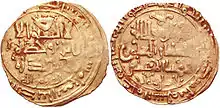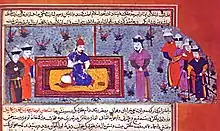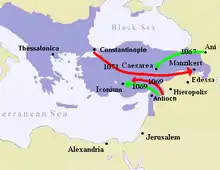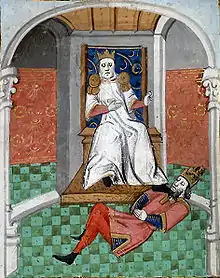Alp Arslan
Alp Arslan (honorific in Turkish meaning "Heroic Lion"; in Persian: آلپ ارسلان; full name: Diyā ad-Dunyā wa ad-Dīn Adud ad-Dawlah Abu Shujā' Muhammad Ālp Ārslan ibn Dawūd ضياء الدنيا و الدين عضد الدولة ابو شجاع محمد آلپ ارسلان ابن داود; 20 January 1029 – 15 December 1072), real name Muhammad bin Dawud Chaghri, was the second Sultan of the Seljuk Empire and great-grandson of Seljuk, the eponymous founder of the dynasty. As Sultan, Alp Arslan greatly expanded Seljuk territory and consolidated power, defeating rivals to his south and northwest. His victory over the Byzantines at the Battle of Manzikert in 1071 ushered in the Turkoman settlement of Anatolia.[1] For his military prowess and fighting skills he obtained the name Alp Arslan, which means "Heroic Lion" in Turkish.
| Alp Arslan آلپ ارسلان | |
|---|---|
 Miniature from the Majma al-Tawarikh by Hafiz Abru; which depicts accession to the throne by Alp Arslan | |
| Sultan of the Great Seljuk Empire | |
| Reign | 4 September 1063 – 15 December 1072 |
| Predecessor | Tughril |
| Successor | Malik-Shah I |
| Born | 20 January 1030 |
| Died | 15 December 1072 (aged 42) Barzam Fortress, near Amu Darya, Khwarezm |
| Consort |
|
| Issue |
|
| House | House of Seljuk |
| Father | Chaghri Beg |
| Religion | Sunni Islam |
Family
Alp Arslan was the son of Chaghri and nephew of Tughril, the founding sultans of the Seljuk empire. His grandfather was Mikail, who in turn was the son of the warlord Seljuk. He was the father of numerous children, including Malik-Shah I and Tutush I.[2] It is unclear who the mother or mothers of his children were. Arslan was known to be married at least twice. His wives included the widow of his uncle Tughril, a Kara-Khanid princess known as Aka Khatun, and the daughter or niece of Bagrat IV of Georgia (who would later marry his vizier Nizam al-Mulk).[3] One of Seljuk's other son's was the Turkic chieftain Arslan Isma'il, whose son Kutalmish contested his nephew's succession to the sultanate. Alp Arslan's younger brothers Suleiman ibn Chaghri and Qavurt were his rivals for the sultanate. Suleiman ibn Kutalmish would later become Seljuk sultan of Rûm. The son of Suleiman was his successor Kilij Arslan, a major opponent of the Franks during the First Crusade and the Crusade of 1101.[4]
Early career


Alp Arslan accompanied his uncle Tughril on campaigns in the south against the Fatimids while his father Chaghri remained in Khorasan. Upon Alp Arslan's return to Khorasan, he began his work in administration at his father's suggestion. While there, his father introduced him to Nizam al-Mulk, one of the most eminent statesmen in early Muslim history and Alp Arslan's future vizier.[5]
After the death of his father, Alp Arslan succeeded him as governor of Khorasan in 1059. His uncle Tughril died in 1063 and had designated his successor as Suleiman, Arslan's infant brother. Arslan and his uncle Kutalmish both contested this succession which was resolved at the battle of Damghan in 1063. Arslan defeated Kutalmish for the throne and succeeded on 27 April 1064 as sultan of the Seljuk Empire, thus becoming sole monarch of Persia from the river Oxus to the Tigris.
In consolidating his empire and subduing contending factions, Arslan was ably assisted by Nizam al-Mulk, and the two are credited with helping to stabilize the empire after the death of Tughril. With peace and security established in his dominions, Arslan convoked an assembly of the states and in 1066, he declared his son Malik Shah I his heir and successor.[6] With the hope of capturing Caesarea Mazaca, the capital of Cappadocia, he placed himself at the head of the Turkoman"[7] cavalry, crossed the Euphrates, and entered and invaded the city. Along with Nizam al-Mulk, he then marched into Armenia and Georgia, which he conquered in 1064.[8] After a siege of 25 days, the Seljuks captured Ani, the capital city of Armenia.[9] An account of the sack and massacres in Ani is given by the historian Sibt ibn al-Jawzi, who quotes an eyewitness saying:
Putting the Persian sword to work, they spared no one... One could see there the grief and calamity of every age of human kind. For children were ravished from the embraces of their mothers and mercilessly hurled against rocks, while the mothers drenched them with tears and blood... The city became filled from one end to the other with bodies of the slain and [the bodies of the slain] became a road. [...] The army entered the city, massacred its inhabitants, pillaged and burned it, leaving it in ruins and taking prisoner all those who remained alive...The dead bodies were so many that they blocked the streets; one could not go anywhere without stepping over them. And the number of prisoners was not less than 50,000 souls. I was determined to enter city and see the destruction with my own eyes. I tried to find a street in which I would not have to walk over the corpses; but that was impossible.[10]
Byzantine struggle

En route to fight the Fatimids in Syria in 1068, Alp Arslan invaded the Byzantine Empire. The Emperor Romanos IV Diogenes, assuming command in person, met the invaders in Cilicia. In three arduous campaigns, the Turks were defeated in detail and driven across the Euphrates in 1070. The first two campaigns were conducted by the emperor himself, while the third was directed by Manuel Comnenos, great-uncle of Emperor Manuel Comnenos. During this time, Arslan gained the allegiance of Rashid al-Dawla Mahmud, the Mirdasid emir of Aleppo.
In 1071 Romanos again took the field and advanced into Armenia with possibly 30,000 men, including a contingent of Cuman Turks as well as contingents of Franks and Normans, under Ursel de Baieul. Alp Arslan, who had moved his troops south to fight the Fatimids, quickly reversed to meet the Byzantines. At Manzikert, on the Murat River, north of Lake Van, the two forces waged the Battle of Manzikert. The Cuman mercenaries among the Byzantine forces immediately defected to the Turkic side. Seeing this, "the Western mercenaries rode off and took no part in the battle."[11] To be exact, Romanos was betrayed by general Andronikos Doukas, son of the Caesar (Romanos's stepson), who pronounced him dead and rode off with a large part of the Byzantine forces at a critical moment.[12] The Byzantines were totally routed.

Emperor Romanos IV was himself taken prisoner and conducted into the presence of Alp Arslan. After a ritual humiliation, Arslan treated him with generosity. After peace terms were agreed to, Arslan dismissed the Emperor, loaded with presents and respectfully attended by a military guard. The following conversation is said to have taken place after Romanos was brought as a prisoner before the Sultan:[13]

Alp Arslan: "What would you do if I was brought before you as a prisoner?"
Romanos: "Perhaps I'd kill you, or exhibit you in the streets of Constantinople."
Alp Arslan: "My punishment is far heavier. I forgive you, and set you free."
Alp Arslan's victories changed the balance in near Asia completely in favour of the Seljuq Turks and Sunni Muslims. While the Byzantine Empire was to continue for nearly four more centuries, and the Crusades would contest the issue for some time, the victory at Manzikert signalled the beginning of Turkmen[1] ascendancy in Anatolia. The battle of, especially the victory at Manzikert became so popular among the Turks that later every noble family in Anatolia claimed to have had an ancestor who had fought on that day.[14]
Most historians, including Edward Gibbon, date the defeat at Manzikert as the beginning of the end of the Eastern Roman Empire.
State organization
Alp Arslan's strength lay in the military realm. Domestic affairs were handled by his able vizier, Nizam al-Mulk, the founder of the administrative organization that characterized and strengthened the sultanate during the reigns of Alp Arslan and his son, Malik Shah. Military fiefs, governed by Seljuq princes, were established to provide support for the soldiery and to accommodate the nomadic Turks to the established Anatolian agricultural scene. This type of military fiefdom enabled the nomadic Turks to draw on the resources of the sedentary Persians, Turks, and other established cultures within the Seljuq realm, and allowed Alp Arslan to field a huge standing army without depending on tribute from conquest to pay his soldiers. He not only had enough food from his subjects to maintain his military, but the taxes collected from traders and merchants added to his coffers sufficiently to fund his continuous wars.
According to the poet Saadi Shirazi:[15]
Qazal Arslа̄n possessed a fort, which raised its head to the height of Alwand. Secure from all were those within its walls, for its roads were a labyrinth, like the curls of a bride.
From a learned traveler Qazal once inquired: "Didst thou ever, in thy wanderings, see a fort as strong as this?"
"Splendid it is," was the reply, "but methinks not it confers much strength. Before thee, did not other kings possess it for a while, then pass away? After thee, will not other kings assume control, and eat the fruits of the tree of thy hope?"
In the estimation of the wise, the world is a false gem that passes each moment from one hand to another.
Suleiman ibn Kutalmish was the son of the contender for Arslan's throne; he was appointed governor of the north-western provinces and assigned to completing the invasion of Anatolia. An explanation for this choice can only be conjectured from Ibn al-Athir's account of the battle between Alp-Arslan and Kutalmish, in which he writes that Alp-Arslan wept for the latter's death and greatly mourned the loss of his kinsman.
Death
After Manzikert, the dominion of Alp Arslan extended over much of western Asia. He soon prepared to march for the conquest of Turkestan, the original seat of his ancestors. With a powerful army he advanced to the banks of the Oxus. Before he could pass the river with safety, however, it was necessary to subdue certain fortresses, one of which was for several days vigorously defended by the governor, Yussuf al-Kharezmi, a Khwarezmian. He was obliged to surrender, however, and was carried as a prisoner before the sultan, who condemned him to death. Yussuf drew his dagger and rushed upon the sultan. Alp Arslan, who took great pride in his reputation as an archer, motioned to his guards not to interfere. He drew his bow, but his foot slipped, the arrow glanced aside, and he received the assassin's dagger in his chest. Alp Arslan died from this wound four days later, on 25 November 1072, in his 42nd year, and he was taken to Merv to be buried next to his father, Chaghri Beg.
Legacy
Alp Arslan is widely regarded as having begun Anatolianism, although unintentionally. His victory at Manzikert is often cited as the beginning of the end of Byzantine power in Anatolia, and the beginning of Turkic identity there.
Alp Arslan's conquest of Anatolia from the Byzantines is also seen as one of the pivotal precursors to the launch of the crusades.
From 2002 to July 2008 under Turkmen calendar reform, the month of August was named after Alp Arslan.
The 2nd Training Motorized Rifle Division of the Turkmen Ground Forces is named in his honour.
References
- Cahen, Claude. "Alp-Arslan". Encyclopedia Britannica. "But the Battle of Manzikert opened Asia Minor to Turkmen conquest"
- K. A. Luther, Encyclopaedia Iranica, Volume I, Fascicle 8, pgs. 895–898. "ALP ARSLAN".CS1 maint: multiple names: authors list (link)
- Bosworth, C. E., Encyclopaedia Iranica, Vol. I, Fasc. 6, pp. 642–643. "AḤMAD B. NEẒĀM-AL-MOLK".CS1 maint: multiple names: authors list (link)
- Peacock, A.C,S., Great Seljuk Empire, Edinburgh University Press, 2015, pgs. 179, 183
- Magill, Frank Northen (1998). Dictionary of World Biography: The Middle Ages, Volume 2. Routledge. p. 67. ISBN 978-1-57958-041-4.
- Magill, Frank Northen (1998). Dictionary of World Biography: The Middle Ages, Volume 2. Routledge. p. 68. ISBN 978-1-57958-041-4.
- Cauhen, Claude. "Alp-Arslan". Encyclopedia Britannica."On the other hand, he was aware of the necessity of keeping his influence over the Oğuz Turkic tribes (sometimes called Turkmens), which was essential to his military strength."
- Bosworth 1968, p. 62-65.
- , Encyclopædia Britannica, 9th ed., Vol. II, New York: Charles Scribner's Sons, 1878, p. 72.
- Quoted in Norwich, John Julius (1991). Byzantium: The Apogee. New York: Viking. pp. 342–343. ISBN 978-0-394-53779-5.
- Runciman, Steve (1992). The First Crusade. Cambridge University Press.
- Norwich, John Julius (1993). Byzantium The Apogee. Penguin. ISBN 0-14-011448-3.
- R. Scott Peoples (2007). Crusade of Kings. Wildside Press LLC. p. 13. ISBN 978-0-8095-7221-2.
- Cahen, Claude. "Alp-Arslan". Encyclopedia Britannica. "Later, every princely family in Asia Minor was to claim an ancestor who had fought on that prestigious day."
- "Story of Qazal Arsalа̄n and the Fort". Wisdom of the East: The Bustа̄n of Sadi. Translated by Edwards, A. Hart. New York: E. P. Dutton. 1911. p. 32.
Sources
- Minorsky, Vladimir (1958). A History of Sharvān and Darband in the 10th–11th Centuries. University of Michigan. pp. 1–219. ISBN 978-1-84511-645-3.
- Bosworth, C. E. (1975). "The early Ghaznavids". In Frye, R. N. (ed.). The Cambridge History of Iran, Volume 4: From the Arab Invasion to the Saljuqs. Cambridge: Cambridge University Press. pp. 162–198. ISBN 0-521-20093-8.
- Bosworth, C. E. (1968). "The Political and Dynastic History of the Iranian World (A.D. 1000–1217)". In Frye, R. N. (ed.). The Cambridge History of Iran, Volume 5: The Saljuq and Mongol periods. Cambridge: Cambridge University Press. pp. 1–202. ISBN 0-521-06936-X.
- Bosworth, C. E. (1975). "Iran under the Buyids". In Frye, R. N. (ed.). The Cambridge History of Iran, Volume 4: From the Arab Invasion to the Saljuqs. Cambridge: Cambridge University Press. pp. 250–305. ISBN 0-521-20093-8.
- Madelung, W. (1975). "The Minor Dynasties of Northern Iran". In Frye, R. N. (ed.). The Cambridge History of Iran, Volume 4: From the Arab Invasion to the Saljuqs. Cambridge: Cambridge University Press. pp. 198–249. ISBN 978-0-521-20093-6.
Alp Arslan Born: 20 January 1029 Died: 15 December 1072 | ||
| Regnal titles | ||
|---|---|---|
| Preceded by Toghrul-Beg |
Sultan of the Seljuq Empire 4 September 1063– 15 December 1072 |
Succeeded by Malik-Shah I |
| Wikiquote has quotations related to: Alp Arslan |